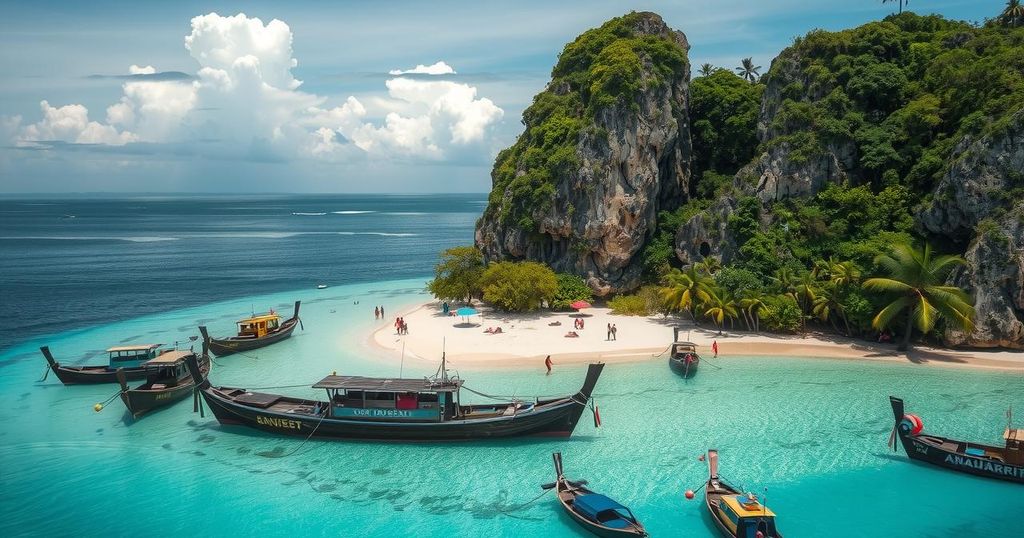The Dispute Over Koh Kood Island: A Historical and Geopolitical Analysis

The dispute over Koh Kood Island between Thailand and Cambodia is driven by its potential oil and gas reserves and rooted in historical territorial agreements. Despite past discussions of compromise, nationalist sentiments, and the ongoing political dynamics are likely to perpetuate the deadlock over the island’s sovereignty. Recent deportations of activists also highlight human rights concerns linked to this geopolitical tension.
The island of Koh Kood, located in the Gulf of Thailand, has become a focal point of contention between Thailand and Cambodia due to its potential vast reserves of oil and gas. While this island is frequented by tourists, its increasing strategic importance has ignited diplomatic tensions, primarily stemming from historical territorial disputes dating back to the early 1900s during French colonial rule in Indochina.
The conflict over Koh Kood’s sovereignty can be traced back to the 1904 agreement that officially ceded the island to Thailand. This agreement was later solidified by the Franco-Siamese Treaty of 1907. However, in 1972, Cambodia contested the maritime boundaries established in the treaty, claiming a part of Koh Kood. Tita Sanglee, an independent analyst, notes that “Cambodia’s claim was rooted in a different interpretation of the said treaty.” She emphasized that the 1907 treaty primarily addressed land territories rather than maritime boundaries, making Cambodia’s claim contentious.
In 2001, negotiations between both nations aimed to address these overlapping claims, with discussions on profit-sharing from the island’s energy resources. Yet, nationalist sentiments in Thailand have created friction over any concessions to Cambodia. The political landscape has shifted in 2025, with leaderships closely related to their predecessors — Paetongtarn Shinawatra in Thailand and Hun Manet in Cambodia. Despite their familial ties which might seem conducive to resolving the dispute, skepticism prevails among Thai nationalists regarding the pace of negotiations and the potential conflicts of interest involved.
Moreover, the ongoing cooperation between the two governments raises concerns over human rights, particularly regarding activists fleeing from the political repression in both nations. The deportation of Cambodian activists by Thailand signals a troubling trend in transnational repression without refuge for dissenters.
As diplomatic dynamics evolve, both Thailand and Cambodia face a delicate balancing act. “If the Cambodian government accepts that Koh Kood belongs to Thailand, it will have to deal with angry nationalists at home,” stated Tita Sanglee. In contrast, any modification to Thailand’s claim over Koh Kood is likely to incite outrage from the Thai populace. This deadlock presents a formidable challenge for both parties as they navigate historical grievances and contemporary geopolitical pressures.
Koh Kood’s significance has escalated due to its suspected substantial energy resources, which are increasingly vital for both Thailand and Cambodia amidst rising energy demands. The territorial dispute is deeply rooted in historical treaties established during the colonial period, specifically the legal arrangements surrounding the boundaries of Indochina. Understanding these historical contexts is crucial to grasping the current tensions, the interpretations of territorial sovereignty, and the role of nationalism in the dispute.
In summary, the conflict over Koh Kood reflects a convergence of historical territorial disputes, contemporary energy needs, and nationalist sentiments in both Thailand and Cambodia. As each nation grapples with the implications of their claims, the evolving political landscape, characterized by familial ties among leadership, further complicates the resolution process. The delicate interplay of nationalism and resource management indicates that the path to a resolution will be fraught with challenges.
Original Source: www.dw.com








